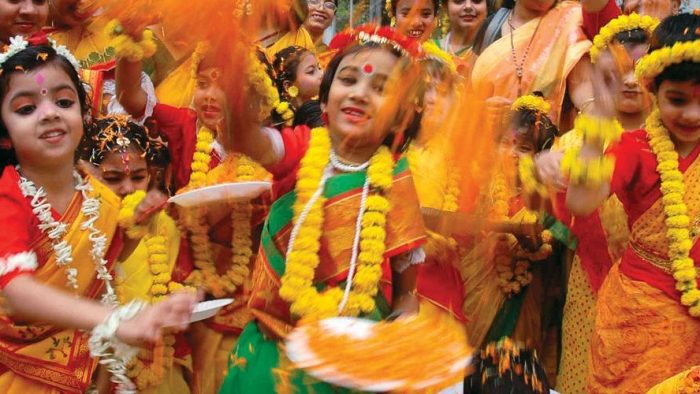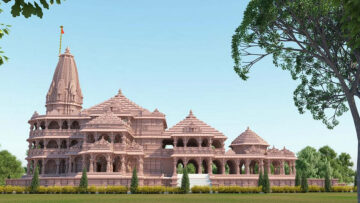This is the first part of a dialogue between Raghu Anantanarayanan and Gayatri Iyer on Hindu Dharma and the challenges facing it today.
As a yoga teacher and practitioner, it is impossible to delve into dharma and Hinduism especially in today’s context where we are pulled and pushed in many narratives. Raghu Ananthanarayanan, a Yogi and coach shares his ideas with Gayatri Iyer after a recently concluded conference on ‘Hindu Dharma Identity and its Role in Global Awakening’ organized by Dena Marriam. The conference dealt with a lot of questions around Hindu trauma, methods to cope with it, and how does one assert a Hindu identity.
Raghu: I found all these topics very interesting, but my focus was to look at the current ways in which an average Hindu behaves. After listening to the various perspectives, I looked at the behavior of the average Hindus in three ways-:
- Apad Dharma – It is a way of masking one’s ‘true’ identity, in the hope that one can keep it safe from any attack and then when the time is fine, one can re-assert the identity without fear. In the Mahabharata there is a story where Vishvamitra is crossing the desert and by the time he comes to the end of the desert he is completely dehydrated. A villager offers him some water and non-vegetarian food. Vishwamitra consumes it and little by little he becomes healthier. He then tells the villager that he will start fetching water for himself and will only eat vegetarian food. The puzzled villager asked, ‘how is it that you were eating everything that I gave you and now you won’t?’ To which Vishvamitra replied ‘allowing my life to get extinguished is adharma. So, I needed to do something to keep myself alive. And, once I have recovered my strength I have to go back and start doing what is right for my dharmic existence.’ What I think has happened in India is this apad dharma has become the dharma. To illustrate, Telugu weddings, which even now happen at night and have a wailing tone in the songs because in the heydays of the Sultanate, it was dangerous to celebrate a Hindu wedding in the day. The local practices in many parts of the country have taken on a very conservative and sometimes excessively introverted mode because of this. These practices have not reverted to the older ways even now and this has become the dharma. The normal Hindu person has accepted this conservatism, non-assertion of oneself that was basically self-protective in the times of Muslim and Christian rule and treated apad dharma, as the dharma. But behind all this is a lot of discontent, frustration and anger.
- The second pattern is displayed by a fringe set who are now asserting dharma in a reactive way. So, it is almost as though the spring has been unleashed and the suppressed anger is getting expressed. Terms like “the Hindu has woken up” are used to describe this brand of assertion. A lot of people who are in a sense locked up in apad dharma are secretly rejoicing when some of these violent eruptions happen.
- The other way in which the average Hindu displays his new-found freedom is acting out an envy of the west or of the far east. For example, our laws, governance processes, education policies, and many of the ways in which we model development are based on an envy of the west. Of late I think the governance processes display an envy of the far east. The processes followed in countries like Singapore and China, where there is a very strong authoritarian government.
None of the above ways help in asserting dharma in a meaningful way.
There is a small group that is anchored in studying our dharma, our history and our tradition through a lens that is Indic. It is this voice that can really lead an Indic renaissance. But often their voices get lost in the crowd.
The real issue is that these three voices do not seem to engage in a meaningful dialogue.
Q. What do you mean by envy? Does it have cultural and political dimension?
Raghu: It is a consequence of not valuing who we are. For e.g. education is synonymous with English/convent education and anyone sending their children to a Gurukula or veda pathashAla is seen as backward. The traditional panchayat system that was the governance model in every village community, is not used anymore. The space that has been opened through the success of the BJP in the elections has also emboldened reactionary Hindus to act out violently against the “other”. This is surely not sanatana dharma nor sarva dharma samabhAva.
Another example is the word ‘secular’, that has its root in Europe. It meant that the Christian kings in Europe should not fight with each other because they were all Christians. The same idea later spread to the Americas. Today, ‘secular’ in the west means separating church from the state. But this word cannot apply in India because our identities are tied to our religions. But we import ideas like this into our constitution without a careful examination. We can and should learn from others, but on our terms. Blind imitation and wholesale un-examined mimicry is very dysfunctional.
Q. Why is this envy taking place?
Raghu: This is because we do not understand our own roots properly in an in-depth manner. Even after independence we have not invested in really understanding our own civilizational roots. Every aspect of human life- economics, psychology, science, governance were quite well developed in India. This has not been studied in any depth post-independence. The people who are studying them today are not invited to influence policy making.
Q. A lot of societal, family or gender norms, which were part of apad dharma, are still in practice without looking at the negative side of it.
Raghu: Yes, the Vedas and Upanishads talked about many women rishis. There is widespread Devi worship in Bengal and Kerala, which have a matrilineal society. We have our own ways of looking at women and this has its own positive and negative aspects. Yet, we have adopted strange Victorian ways of understanding and treating women.
Q. How does one look at the hurt; humiliation and shame when we learn about our temples being destroyed and looted by invaders. These hurts are very deep, and I think it is one of the reasons why there is a reactionary comeback by Hindus.
Raghu: It is important to look at all of these too. The Kashi Vishwanath Mandir was destroyed and rebuilt quite a few times. The last person to rebuild it was Ahalyabai Holkar. We can see the evidence of the continuous attack and destruction of Hindu monuments everywhere in North India. The horrors of the partition are not old history. But there is no attempt to look at this honestly and go through a “truth and reconciliation” process. The wounds are held within and coping mechanisms have become the norm. This suppressed and repressed trauma will burst out in very negative ways and breed hate.
Q. How do we understand dharma and apad dharma?
Raghu: Dharma, at a simple level is any action that enlivens me, the people I interact with and the context simultaneously. dharma in a context of oppression and survival will then become imbued with superficial conformity and a hiding of ones’ real self. An undertone consisting of fear of assertion will accompany one all the time because, if I assert myself, I am going to attract violence. Krishnamacharya has spoken about it; when he was young, in some places outside of Mysore, the Razakars would come riding on their horses and behave violently every now and again just to spread terror in the town. The common folk would be in a state of uncertainty and withdraw into their shells, large scale community celebrations would be suspended, and in this way many rituals have been lost. The do’s and don’ts of such circumstances get carried forward and become rigid as ground rules. These then become the new norms: apad dharma becomes dharma!
Q. Isn’t the caste system also a result of this?
Raghu: Yes, I think that it is a result of apad dharma. Because during my upanayanam I am given all the symbols of a hunter, of a herdsman, of a Vaishya or trader and then asked to make a choice of what I want to do in life. If I make a choice to seek truth, then I am taken through the process of initiation in the Brahmanical ways and the gifts of Vamana are given to me. But the way the ritual is practiced today is not a celebration of a choice making process but a ritualistic procedure. We know that all varnas and women wore the sacred thread in ancient times. Today this tradition is held on to by Brahmins and is a pale shadow of its original intent. How then are we to claim that these rituals and norms are based on dharma? They get translated into cultural norms without the understanding of the basic ideas of dharma. When these get solidified and held on to as proxy symbols of status, they create the conditions for a meaningless and rigid way of living. The fear in which they are held and the proxy sense of value that they provide do not allow for an honest reappraisal and re-calibration. We then have two sets of people: the ones who follow ancient ways rigidly and the ones who reject them. Neither of them is making an informed choice.
Q. What is preventing the process of review and regeneration?
Raghu: In my understanding, it is the absence of two processes-:
We Hindus need to reappraise our history honestly and through our own lenses. We must look at the glorious times and the colonized times honestly. Today we do neither.
We must study our knowledge systems carefully to unearth the design intent of many of them, understand the social and cultural practices that remain in forms that have lost vitality or have become rigid and dysfunctional. Through this study we could develop new frames for action review and regenerate what is meaningful for today. There is very little of this happening.
Q. What do you mean that we need to understand our defeat?
Raghu: There is a clear break in the narrative of Bharat from the 11th century. We were celebrated for our technology and science, for our universities, for our trade and so on. We either controlled or influenced large parts of the world from Afghanistan to Cambodia. From the 11th Century our narrative is one of being ruled by muslim invaders and of constant strife. There is a period of adjustment and relative peace under the Moghuls, and then a sharp decline under British occupation. We cannot look at this decline through the eyes of a victim. No civilization is defeated from the outside unless the rot has already set in. What was this rot? What parts of it are still there? What has enabled us to maintain a civilizational continuity when no other ancient civilization has survived in a living form? How can this stream be revitalized?
Q. How do I look at this whole situation now?
Raghu: I suggest that we anchor ourselves in the pride of being a Hindu. We must accept the mistakes and shameful things that we have done. Recently, I read a nice paper discussing atithi devo bhava and why it is a dysfunctional dharma today. Further, the paper went on to call Hindus as the ‘innocent-victims’. I do not think we are innocent victims at all. We colluded with invaders, we oppressed our own people, got defeated and colonized. But we must own up to the wrong things we have done from a location of dignity and honest reappraisal, not from a location of shame. The location of shame will only result in self-condemnation on the one hand and envy on the other hand.
Q. Can we examine what you mean by “locating in shame” a little more?
Raghu: For e.g. if I am envious of the west, I will look at everything that has happened to India today and say ugly things about it, without understanding that we are an impoverished nation. What we see today is the result of the years of colonization. What you see today is a very sad form of what was intended. But if I sit in a space of dignity and compassion, I can look at things that are beautiful even today. We have been able to hold a continuity where no indigenous population in the world has survived colonization; we still have the Vedas to talk about; every other civilization has been wiped out including Greece and Egypt. We have many amazing things to celebrate and foster. How do we heal the trauma? How do we start a dialogue that is balanced? How do we reclaim the intent of the civilization and rebuild for today?
Thus, my point is that we cannot respond from the space of reactivity to any of these experiences. We then get into glorifying ourselves or becoming aggressive with our detractors. We must continuously look at the framework from which we understand what is Indian; review it, polish it, understand it better and better.
Q. This also means that we cannot simply wish and hope to relive the past glory?
Raghu: Yes, that becomes reactive too. Like the constant chest thumping that “we were great, we are great” without the understanding of the context of how things unfolded and why? The practice of ahimsA is very different in Buddhist, Jain and Hindu traditions. Ayurveda talks about the relevance of the kind of work a person perform and the food one eats, so meat is not taboo. Understanding the framework is a good practice to look at these questions. Only then would I have a better answer. The principles can then be reapplied in todays’ context.
Q. It is difficult for everyone to really be anchored in dignity rather than shame. Where does one start?
Raghu: Let us examine this discussion. Our discussion started with a vitarka or different points of view and a debate. But the debate is not coming from a space of shame or ‘proving a point’. From here it is possible to move to vichAra (enquiry). It may take a long time before a breakthrough, but there is an exploration. If I use the yoga sutra framework our enquiry ought to move through the 4 stages: vitarka-vichAra-Ananda (the delight of discovery) -asmitA (self-transformation) which means you discover a true and meaningful way to live at the end of the dialogue.
If we apply a yogic lens to define a karma yogi of today, we will define three anchors of action, namely, duHkha nivArana is one anchor, second is ahimsA and satya is the third. If you anchor yourself in these three along with some dignity or wholesomeness in being an Indian, you can look at the reality today and see how to re-energize yourself.
Q. Once I have this framework, then how do I move forward?
Raghu: It is important to anchor yourself in a meaningful continuity i.e. anchoring in the heritage you have received and moving forward does not mean getting stuck. We must discover ways of understanding the current reality through our lenses, and find meaningful solutions based on our genius. Our culture has been very good at assimilation and I think A.R.Rahman’s music is a great example of this capability. India might be in a unique position to bring together the best of the west and the best of our own tradition. We have never had a science vs religion face-off; we have never had an “ingroup solidarity out group violence” mentality. We must build on this and develop a robust, contemporary way of living and evolving. If the unacknowledged envy and withheld trauma is not released, we might sink into deep divisiveness and then the cultural capital that powered the Gandhian non-violent approach to winning Independence will be eroded.
Q, Now, there are groups who call themselves ‘Hindus or Indians’ and are stuck in the glories of the past.
Raghu: True, they do not want to assimilate the current reality and that is a huge problem. This is the problem with Abrahamic religions also, which say that ‘only I am right’ and I do not believe in what you believe in. Thus, you have no right to live, you will be branded as a heathen or kafir. This attitude will deepen the divisiveness.
Continued in the next part.
Disclaimer: The opinions expressed in this article belong to the author. Indic Today is neither responsible nor liable for the accuracy, completeness, suitability, or validity of any information in the article.









